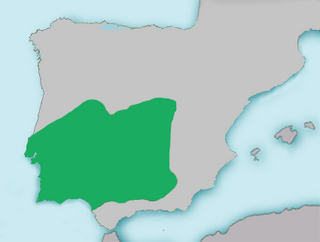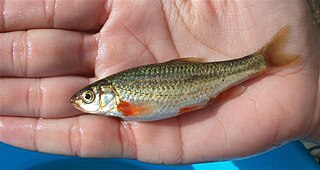
Cyprinidae is a family of freshwater fish commonly called the carp or minnow family, including the carps, the true minnows, and their relatives the barbs and barbels, among others. Cyprinidae is the largest and most diverse fish family, and the largest vertebrate animal family overall, with about 3,000 species; only 1,270 of these remain extant, divided into about 370 genera. Cyprinids range from about 12 mm in size to the 3 m (9.8 ft) giant barb. By genus and species count, the family makes up more than two-thirds of the ostariophysian order Cypriniformes. The family name is derived from the Greek word kyprînos.

Carpet sharks are sharks classified in the order Orectolobiformes. Sometimes the common name "carpet shark" is used interchangeably with "wobbegong", which is the common name of sharks in the family Orectolobidae. Carpet sharks have five gill slits, two spineless dorsal fins, and a small mouth that does not extend past the eyes. Many species have barbels.

Puntius is a genus of small freshwater fish in the family Cyprinidae native to South Asia and Mainland Southeast Asia, as well as Taiwan.
Gymnotus is a genus of Neotropical freshwater fish in the family Gymnotidae found widely in South America, Central America and southern Mexico. The greatest species richness is found in the Amazon basin. They are sometimes referred to by the English name banded knifefish, although this typically is reserved for the most widespread species, G. carapo. Overall Gymnotus is the most widespread genus in the order Gymnotiformes.

The collared peccary is a species of artiodactyl (even-toed) mammal in the family Tayassuidae found in North, Central, and South America. It is the only member of the genus Dicotyles. They are commonly referred to as javelina, saíno, or báquiro, although these terms are also used to describe other species in the family. The species is also known as the musk hog. In Trinidad, it is colloquially known as quenk.
Pareiorhaphis is a genus of catfish in the family Loricariidae native to South America. This genus can be readily distinguished from other neoplecostomines by the unique combination of having fleshy lobes on lateral margins of head ornamented with hypertrophied odontodes on nuptial males, caudal peduncle ovoid in cross section, abdomen usually naked, dorsal fin spinelet ovoid and adipose fin usually present. The color pattern is usually dark brown and mottled with the abdomen white. Most species in to Pareiorhaphis were originally described in Hemipsilichthys. In 1918, Alípio de Miranda-Ribeiro proposed the new genus Pareiorhaphis. Whether Pareiorhaphis is monophyletic or not is currently unknown.

Anaecypris hispanica, the Spanish minnowcarp, is a small species of ray-finned fish species in the family Cyprinidae. It is the only living member of the genus Anaecypris. It is endemic to the Iberian Peninsula and is found in the basin of the Guadiana River in southern Spain and Portugal. Its natural habitats are rivers and intermittent rivers which are shallow, highly oxygenated, have a water temperature of no more than 25 °C and have a coarse stream bed. It is threatened by habitat loss. They grow to a maximum size of 60mm and live for three years.

Chondrostoma is a genus of ray-finned fish in the family Cyprinidae. They are commonly known as nases, although this term is also used locally to denote particular species, most frequently the common nase . The common name refers to the protruding upper jaw of these fishes; it is derived from the German term Nase 'nose'.

The Northern straight-mouth nase is a species of ray-finned fish in the family Cyprinidae. It is found in Portugal and Spain. Its natural habitat is rivers. It is threatened by habitat loss.
Iberochondrostoma oretanum is a species of cyprinid fish endemic to Spain where it is found in the Robledillo and Fresnada rivers, tributaries of the Jándula in the Guadalquivir system.

The Iberian nase is a species of freshwater fish in the family Cyprinidae. It is found in Portugal and in Spain. Its natural habitats are rivers and intermittent rivers.

Pseudochondrostoma willkommii is a species of cyprinid fish. It is found in Portugal and Spain. Its natural habitats are rivers and water storage areas. It is threatened by habitat loss.

Iberochondrostoma lemmingii is a species of ray-finned fish in the family Cyprinidae. It is found in Portugal and Spain. It lives in the middle and lower reaches of rivers with slow current.

Squalius alburnoides is a species of fish in the family Cyprinidae. It is found in Portugal and Spain. Its natural habitats are rivers and intermittent rivers. It may be threatened by habitat loss.
Squalius is a genus of fish in the family Cyprinidae found in Europe and Asia. Hybridization is not rare in the Cyprinidae, including this genus. S. alburnoides is known to be of ancient hybrid origin, with the paternal lineage deriving from a prehistoric species related to Anaecypris; the latter mated with ancestral S. pyrenaicus. Present-day S. alburnoides mates with sympatric congeners of other species.

Achondrostoma is a genus of freshwater fish in the family Cyprinidae, the carps and minnows. It is endemic to the Iberian Peninsula.

Achondrostoma arcasii, termed the bermejuela, is a species of freshwater fish in the family Cyprinidae. It is found in the Douro River in northern Portugal and in rivers draining to both the Atlantic Ocean and the Mediterranean, including the Ebro River, in northern Spain where it is threatened by loss of habitat caused by the building of canals and the construction of dams, as well as by introduced predators and water pollution.

Iberochondrostoma olisiponensis, the Lisbon arched-mouth nase, is a freshwater fish discovered in 2007 in the lower Rio Tejo basin, Portugal.

Leuciscinae is a subfamily of the freshwater fish family Cyprinidae, which contains the true minnows.

Haemulon is a genus of fish in the grunt family known as the scaled-fin grunts. Most are found in the western Atlantic Ocean, with a few species known from the eastern Pacific Ocean. This genus is considered to be one of the most important fish groups of the coral reefs of Brazil due to its commercial value and crucial ecological role.
















